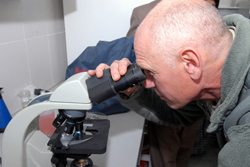National Guard veterinarians learn Afghan capabilities
By U.S. Army Spc. James Wilton
Task Force Red Bulls
 Army Maj. Loren Adams, a New Liberty, Iowa, resident and a veterinarian with the Iowa National Guard Agribusiness Development Team, examines an anthrax slide through a microscope in the Central Veterinary Research and Diagnostics Lab in Kabul City here during a tour Dec. 28. The tour gave a group of Army vets a better understanding of the lab’s capabilities which they will pass on to the Afghan veterinarians they work with, in their respective provinces. (Photo by U.S. Army Spc. James Wilton, Task Force Red Bulls Public Affairs)
Army Maj. Loren Adams, a New Liberty, Iowa, resident and a veterinarian with the Iowa National Guard Agribusiness Development Team, examines an anthrax slide through a microscope in the Central Veterinary Research and Diagnostics Lab in Kabul City here during a tour Dec. 28. The tour gave a group of Army vets a better understanding of the lab’s capabilities which they will pass on to the Afghan veterinarians they work with, in their respective provinces. (Photo by U.S. Army Spc. James Wilton, Task Force Red Bulls Public Affairs)
 download
hi-res photo
download
hi-res photoKABUL PROVINCE, Afghanistan (1/6/11) - A group of U.S. Army veterinarians – including National Guardmembers from two Agribusiness Development Teams – visited the Afghan Central Veterinary Research and Development Lab here Dec. 28 to better understand its capabilities.
The visit included representatives from the Kentucky National Guard ADT II, the Iowa National Guard ADT, the 62nd Cooperative Medical Assistance Brigade and the 411th Civil Affairs Battalion.
The knowledge gained from the visit will help the veterinarians design their workshops, where they train and work with Afghan vets on the provincial and district level.
The Kentucky ADT-II works with vets from Panjshir, Parwan and Kapisa provinces, where the Iowa ADT and 411th work with vets in Kunar and Kandahar.
The tour was guided by Dr. Gulam Mohammad Ziay, director of Animal Health and Welfare at CV RDL, and Dr. Daad Mohammad Amir, chief executive technical director for the Dutch Committee for Afghanistan, VetServ. Dr. Mohibullah Halimi, director general of Animal Health and Production from the Afghan Ministry of Agriculture Irrigations and Livestock, also attended.
“Local vets are key players in responding to animal disease, a constant threat to Afghanistan, which is largely an agricultural country,” said Army Col. James Floyd, a Shreveport, La., native and a veterinarian with the Kentucky ADT-II.
“Most Afghan families outside of urban areas keep livestock, and in order to prevent disease in these animals, vets in those locations must reliably be able to diagnose their causes.”
The CV RDL, which opened in 2009, is the main laboratory controlling 13 provincial labs and six regional labs in Afghanistan.
The labs are used to diagnose and document diseases in livestock and report the findings to the MAIL. Fast, proper detection and documentation of these issues helps to ensure the livelihood and health of the Afghan people.
“This is about the future of Afghanistan,” Ziay said. “The country of Afghanistan needs to establish a standardized system designed to properly track and take samples from livestock, then test and diagnose diseases, reporting the finding to the government and we have done that; all that is left is implementation.”
The CV RDL confirms the diagnosis made in the field by Afghan vets in the smaller provincial and regional labs as well as conducting training and drafting standardized regulations for those facilities.
The facility has departments specializing in histopathology, toxicology, biochemistry, drug analysis, public health and a school to train laboratory technicians.
The public health department deals with monitoring and testing products for import and export making sure they’re safe for human consumption or use.
